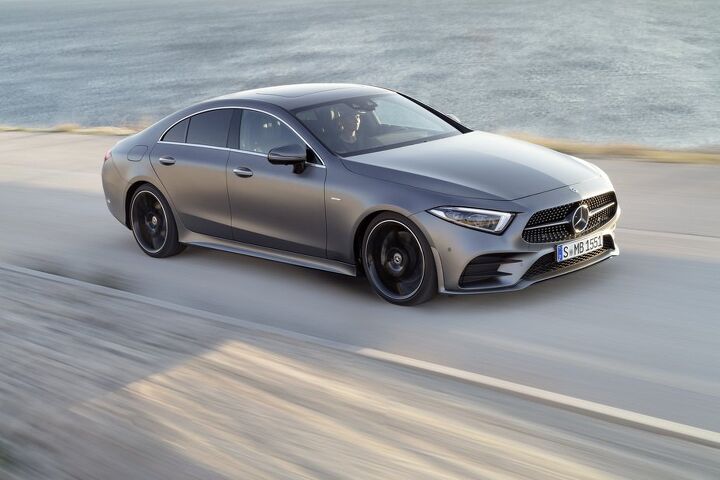2019 Mercedes-Benz CLS450: Put On An Unhappy Face

What is it about the new crop of vehicles? It’s great that the”cheerful” phase in automotive styling is over (the demented visage of those old Mazda 3s still haunt my nightmares), but what we’re left with, at least in the passenger car segment, is enormous, angry grilles or, in the case of the 2018 Ford Mustang and next-generation Mercedes-Benz CLS, a kind of sad face.
Why the droopy eyes, Mercedes?
Whatever the reason, the automaker is bringing more than a questionable front end treatment to the table with its third-generation CLS. The sedan that started the four-door coupe craze (which then jumped ship to the SUV segment) adopts a host of changes for 2019, not the least of which is a new engine that should have both purists and futurists smiling.
All hail the inline six.
Under the CLS’s long hood rests M-B’s latest powertrain offering — a turbocharged 3.0-liter inline-six that adopts a hint of green in order to reduce fuel consumption. Featuring a 48-volt electrical system and integrated starter-generator, the mild hybrid setup also offers drivers a shot of added grunt.
The gasoline engine’s potential tops out at 362 horsepower and 369 lb-ft of torque. Should a driver request extra puissance, its electrical alter ego goes to work, adding a further 21 hp and 184 lb-ft for a “short period.” Mercedes calls the engine’s electrical alter ego “EQ Boost,” claiming it assists the gas engine during acceleration and makes gas-free driving at speed (“sailing”) a possibility. It also restarts the engine when the driver releases the brake pedal at a stoplight, furthering gas mileage gains.
Sending the power to the rear (or all four) wheels is the responsibility of a nine-speed automatic transmission.
If you’re wondering what all of this electrical magic can do for the smooth six’s thirstiness, keep waiting — Mercedes hasn’t endowed the CLS450 or CLS450 4Matic with any fuel economy estimates. Rather, the automaker claims the electrified straight six offers the performance of a V8 with “significantly lower consumption.” Acceleration times, like the model’s price, will also have to wait.
Beneath the model’s “Sensual Purity” skin (characterized by sharp edges, clear contours, and reduced lines) lies more than just a fancy engine. The driver assistance package contains features too numerous to mention. Some of the features, borrowed from the new S-Class, are significantly improved, among them Active Lane Change Assist. Mercedes’ Energizing Comfort system allows drivers to program all elements of the vehicle’s creature comforts (including HVAC controls, seating position, seat and steering wheel heaters, lighting, and, yes, fragrancing) to suit their ever-changing mood.
Among other new features, the key dimension is width. The cockpit’s wavy dash design is meant to give an appearance of added breadth. The central digital display stretches to 12.3 inches, and can be coupled with a second display of the same width for a true Digital Age driving experience. Even the LED headlamps adopt an extra-wide low beam setting.
Beneath the car, an improved Air Body Control air suspension offers enhanced damping that drivers can change up at will. Surely, no driver wants road bumps perturbing their fragrance-enhanced ride, or that of their four passengers (yes, there’s a full rear bench now).
The 2019 Mercedes-Benz CLS goes on sale in late 2018.
[Images: Daimler AG]

More by Steph Willems
Latest Car Reviews
Read moreLatest Product Reviews
Read moreRecent Comments
- Analoggrotto Does anyone seriously listen to this?
- Thomas Same here....but keep in mind that EVs are already much more efficient than ICE vehicles. They need to catch up in all the other areas you mentioned.
- Analoggrotto It's great to see TTAC kicking up the best for their #1 corporate sponsor. Keep up the good work guys.
- John66ny Title about self driving cars, linked podcast about headlight restoration. Some relationship?
- Jeff JMII--If I did not get my Maverick my next choice was a Santa Cruz. They are different but then they are both compact pickups the only real compact pickups on the market. I am glad to hear that the Santa Cruz will have knobs and buttons on it for 2025 it would be good if they offered a hybrid as well. When I looked at both trucks it was less about brand loyalty and more about price, size, and features. I have owned 2 gm made trucks in the past and liked both but gm does not make a true compact truck and neither does Ram, Toyota, or Nissan. The Maverick was the only Ford product that I wanted. If I wanted a larger truck I would have kept either my 99 S-10 extended cab with a 2.2 I-4 5 speed or my 08 Isuzu I-370 4 x 4 with the 3.7 I-5, tow package, heated leather seats, and other niceties and it road like a luxury vehicle. I believe the demand is there for other manufacturers to make compact pickups. The proposed hybrid Toyota Stout would be a great truck. Subaru has experience making small trucks and they could make a very competitive compact truck and Subaru has a great all wheel drive system. Chevy has a great compact pickup offered in South America called the Montana which gm could make in North America and offered in the US and Canada. Ram has a great little compact truck offered in South America as well. Compact trucks are a great vehicle for those who want an open bed for hauling but what a smaller more affordable efficient practical vehicle.





































Comments
Join the conversation
It's not a beauty, but it's less of an eyesore than the previous one. I still like the original CLS best -- that's going to be a classic, I think.
Except for the aggressive front fascia, the cleanliness of this design nearly matches that of my 2006 CLS 500 and in my view represents a vast improvement over the recent wrinkled offerings.